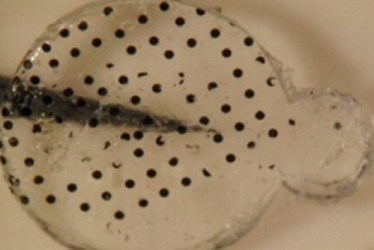Artificial Retina Could Aid The Visually Impaired
By Chuck Seegert, Ph.D.

Researchers recently developed a composite structure has been shown to detect light and transmit signals to retinal neurons. The carbon nanotube and semiconductor nanorod film could serve as a compact replacement for damaged retinas.
Retinal damage or degeneration can lead to a loss of vision, which can alter a person’s life dramatically. Age-related macular degeneration (AMD) is a form of retinal damage that affects people as they approach retirement age, limiting their vision. Attempts to develop implants for AMD have been cumbersome to date and generally haven’t been effective.
Recently, however, an international team from Tel Aviv University, The Hebrew University of Jerusalem Centers for Nanoscience and Nanotechnology, and Newcastle University in the United Kingdom developed a potential solution, according to a recent press release from the American Chemical Society. The team developed a prosthetic retina by incorporating semiconductor nanorods and carbon nanotube patches to create a flexible film. The film was capable of light-induced retinal stimulation and could provide a better treatment option for those suffering from AMD.
Using a flexible acrylic acid layer as an intermediate, the semiconductor nanorods were covalently bound directly to the carbon nanotubes, which are capable of neuroadhesion, according to a study published by the team in ACS Nano. The stimulation of the nanorods with light led to an electrical charge which was effectively transferred to the carbon nanotubes. The nanotubes then conducted the electricity through the neurons they were adhered to, causing retinal nerve stimulation. With the close association of all these materials, the stimulation occurred through direct electrical transfer and required no wires to operate. The success of the approach was further emphasized by the fact that the team used a chick retina model, which normally is insensitive to light.
Compared to the technologies tried historically, this new technology is much more efficient, more flexible, and can stimulate neurons more effectively, according to the press release. The new device is compact, unlike previous designs that used wires or metals while attempting to sense light. Additionally, the new prosthetic is capable of much higher spatial resolution, whereas older designs struggled in this area.
In addition to developing retinal prosthetics, medical device research in the field of retinal degeneration is focused on diagnostics. Recently, in an article on Med Device Online, a non-invasive diagnostic method was discussed that allowed visualization of the retinal vasculature.
Image Credit: American Chemical Society
